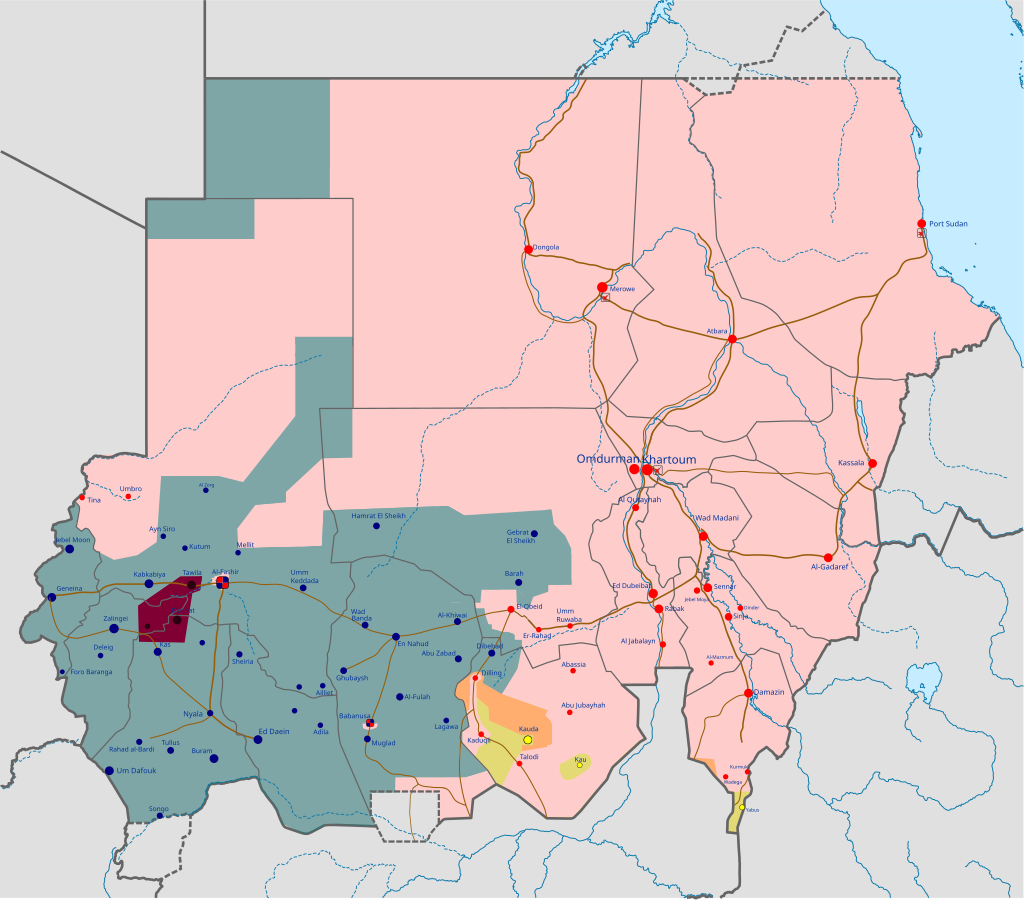Military Situation Map of the Sudanese Civil War on July 31, 2025


Marcus Rodriguez
Historical Geography Expert
Marcus Rodriguez specializes in historical cartography and geographic data analysis. With a background in both history and geography, he brings unique...
Geographic Analysis
What This Map Shows
The visualization titled "Military Situation of the Sudanese Civil War on 31 July 2025" presents a detailed geographical overview of the ongoing conflict in Sudan. Utilizing a color-coded scheme, the map delineates territorial control by various factions involved in the civil war. Light red indicates areas held by the Government of Sudan, teal represents the Rapid Support Forces (RSF), yellow shows control by the Sudan People's Liberation Movement-North (SPLM-N), orange signifies regions held by allied forces of the RSF and SPLM-N, and dark red marks territories controlled by the Sudan Liberation Movement (SLM), specifically the faction led by Abdel Wahid al-Nur. This map encapsulates both the complexity and intensity of the conflict, illustrating the shifting lines of control and the multifaceted nature of the struggle.
Deep Dive into the Sudanese Civil War
The Sudanese Civil War, which reignited in 2023, is a culmination of longstanding political, social, and economic grievances. The conflict primarily pits the Sudanese government, led by military figures, against various rebel groups, each with its own agendas and regional bases of support. The complexities of Sudan's ethnic and political landscape have led to a protracted struggle that has dramatically affected the civilian population.
The map reveals a fragmented country, with zones of influence that shift frequently due to ongoing hostilities. The Government of Sudan, depicted in light red, maintains control over major urban centers, including the capital, Khartoum. However, its grip is challenged continuously by the RSF, a paramilitary group originally formed during the Darfur conflict, which has emerged as a significant player in the current civil war.
Interestingly, the RSF's expansion into new territories is notable, as they seek to establish dominance in both urban and rural areas. This has resulted in a complex web of alliances and enmities among different factions, including the SPLM-N, which is primarily active in the southern regions. The SPLM-N's control, shown in yellow, reflects its historical roots and ongoing struggle for autonomy and rights for marginalized communities in Sudan.
In addition to these factions, the dark red areas controlled by the SLM (al-Nur) illustrate the persistence of the Darfur conflict, highlighting that the roots of Sudan’s violence extend beyond the current civil war. The SLM’s focus on Darfur and its demands for justice and representation add another layer of complexity to the situation.
Regional Analysis
Looking closely at the map, one can observe distinct regional patterns in military control. For instance, the Darfur region in the west has seen significant activity from the SLM, where the dark red zones indicate strongholds that have resisted government control. Conversely, the central and eastern areas of Sudan are more dominated by the Government of Sudan and its allied forces, presenting a stark contrast in levels of governance and stability.
In contrast, the southern regions demonstrate a more fragmented control, with the SPLM-N carving out territories that reflect its historical claim to these areas. The alliances between the RSF and SPLM-N, marked in orange, suggest that despite their differences, these groups have found common ground in opposition to the central government. This highlights the fluid nature of alliances in conflict zones, where temporary partnerships can emerge based on shared interests.
Significance and Impact
The military situation depicted in this map is not merely a reflection of territorial control; it has profound implications for the humanitarian situation in Sudan. As of July 2025, millions of civilians are affected by the ongoing violence, displacement, and economic instability. The complexities illustrated in the map signify a country in turmoil, where the potential for resolution seems distant amid entrenched positions and ongoing hostilities.
Moreover, the international community is closely watching these developments, as Sudan's stability is critical for regional security in Northeast Africa. The ongoing conflict has ramifications that extend beyond its borders, affecting neighboring countries through refugee flows and cross-border militancy.
As we look toward the future, the projections surrounding the Sudanese Civil War suggest that without meaningful dialogue and reconciliation efforts, the cycle of violence is likely to continue. The map serves as a stark reminder of the challenges faced by a nation grappling with its identity and future amid a backdrop of conflict.
Understanding the military situation in Sudan is essential for grasping the broader dynamics at play in the region. As this conflict evolves, so too will the patterns of control, alliances, and ultimately, the prospects for peace and stability in one of Africa's most complex crises.
Visualization Details
- Published
- August 11, 2025
- Views
- 358
Comments
Loading comments...